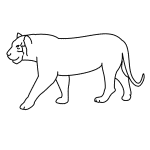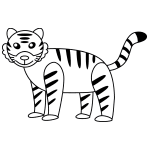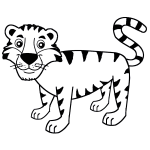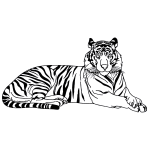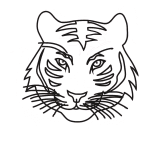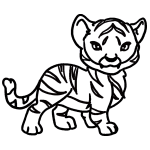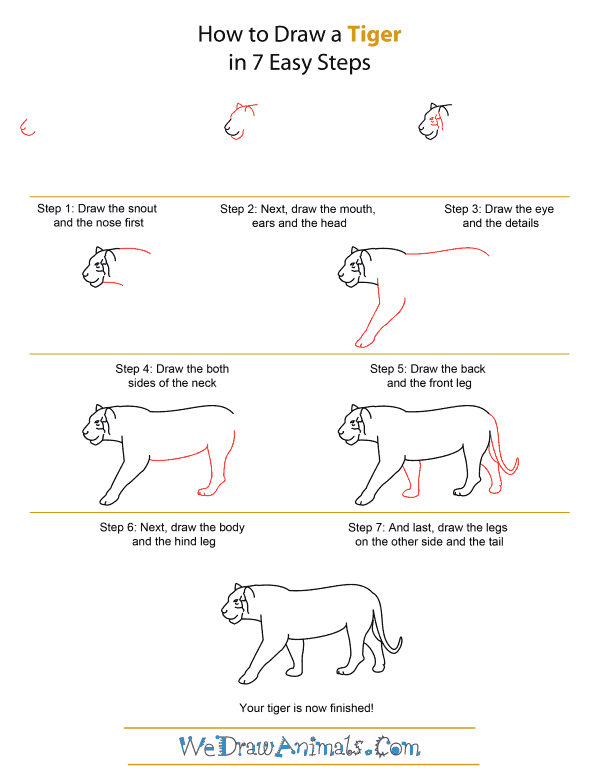In this quick tutorial you'll learn how to draw a Tiger in 7 easy steps - great for kids and novice artists.
The images above represent how your finished drawing is going to look and the steps involved.
Below are the individual steps - you can click on each one for a High Resolution printable PDF version.
At the bottom you can read some interesting facts about the Tiger.
Make sure you also check out any of the hundreds of drawing tutorials grouped by category.
How to Draw a Tiger - Step-by-Step Tutorial
Step 1: First draw a short crooked "U" shaped snout and nose. There is a small curved line toward the top. This is the nose. The snout is twice the width of the nose.
Step 2: Now draw a curved line under the snout to make the lower jaw. Continue the top nose line up to make the head. Add two pointy ears at the top of the head.
Step 3: Just below the top ear add the small eye. Below the front ear add the squiggly lines to make the fur markings.
Step 4: Draw lines from the top of the head and the bottom to make the thick neck.
Step 5: Continue the back line across and curve it down around the rump. At the end of the front neck line start drawing the thick front leg down. The bottom part of the leg bends slightly down to the front paw. Angle the line back up. Make the top part of the front leg sider than the bottom.
Step 6: Start the belly line right behind the front leg. Continue drawing the line straight back. Draw the hind leg down into the back paw. The bottom of the leg is the same width as the front leg but the top is a bit wider. Draw the back of the hind leg up almost to the back of the rump line.
Step 7: Just behind the front leg add another front leg. The other hind leg starts just behind the first hind leg. Finally, add the long thin tail. Curve it down and back up just at the tip.
Interesting Facts about Tigers
Tigers are a very popular big cat. They are usually orange with black stripes, but they can also be white with black stripes. You may think that your pet cat acts a lot like a tiger sometimes, and that’s because they are related to each other! Tigers are like a big cousin of the house cat. Tigers also live in the forests, swamps, and rain forests of Asia.
Over 100,000 tigers roamed widely across Asia at the turn of the 20th century. Today, there are only about 3,000 – 4,000 wild tigers living in small, remote regions of Asia.
Did you know?
- A tiger’s favorite foods are deer and pigs, which it hunts in the wild. Sometimes, they will even eat rhinos and elephants!
- Tigers have a natural camouflage that helps them to blend in with the grass and forests where they live.
- Tigers are an endangered species, because humans have hunted them so much over time. We all need to work together to help save the tigers.
- A baby tiger is called a cub. Cubs only weigh about two pounds, which is lots less than their parents!
- A mother tiger usually has twins or triplets when she gives birth.
Tigers are among the most popular of large, wild animals worldwide and have been featured in ancient mythology, folklore, books and films.
Sadly, out of the 10 subspecies of tiger, only six still exist today; the Bengal tiger, the Siberian tiger, the South China tiger, the Indochinese tiger, the Malayan tiger and the Sumatran tiger.
Fortunately, many people and organizations are working hard to help keep the magnificent tiger from becoming extinct.
Lesson Note: Draw a picture of a tiger and make enough copies so that every child can have one. Place a different number of stripes in a different pattern on each tiger, using a black marker. Ask the students to color their tigers and draw them in their natural surroundings (forest, grass, etc). Then, call on students to count the number of stripes on their tigers and tell the class.

